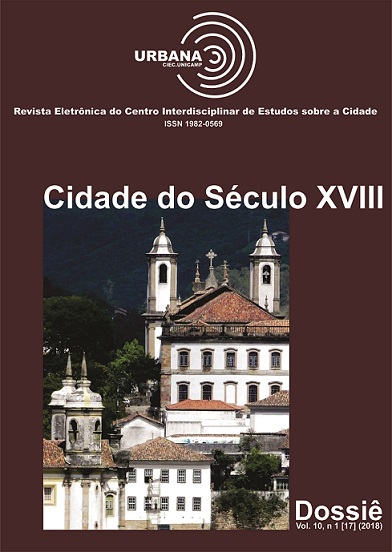Abstract
When analysing the conformation of the cities founded by the Spaniards in the America from the beginning of the sixteenth century, the impressive process of elaborating a regular typology of the city is latent: a tendency of ordering referring to the plan that generated human settlements repeated over and over again, in the most diverse regions of the vast territory under the dominion of the peninsular metropolis – culminating in the realization of a model of city that would present an absolutely Cartesian organization. In opposition to the first two centuries of colonization, the urban scene in the Seventeenth century aim at a dramatic urban landscape – allied with baroque poetics –, hardly expressed in the damero. Therefore, ordered cities should accept on interventions – urbanistic, but especially architectural scale – that act "against" the grid. That is, through the corruption of the rigid scheme of the Hispano-American traza and the inclusion of exuberant examples of religious architecture, colonial settlements could be transfigured for the sake of exaltation of scenographically dramatic events.
References
ALLENDE CARRERA, Arnulfo. Puebla. Y el Paseo de San Francisco. Madrid: Turner, 2006.
BAYÓN, Damián. Sociedad y arquitectura sudamericana. Una lectura polémica. Barcelona: Gustavo Gili, 1974.
DECAEN. México y sus alrededores. México: Estabelecimiento litográfico de Decaen, Editor, 1855.
CHUECA GOITIA, Fernando. El Barroco hispánico y sus invariantes. In: MINARDI, Vittorio (org.). Simposio internazionale sul Barocco Latino Americano. Atti. Roma: Istituto Italo-Latino Americano, v. 1, p. 189-200, 1980.
CHUECA GOITIA, Fernando; TORRES BALBÁS, Leopoldo. Planos de ciudades Iberoamericanas y Filipinas. Madrid: Instituto de Estudios de Administración Local, 1981.
ESCUDERO ALBORNOZ, Ximena. Iglesias y conventos de Quito antiguo. Guía para visitar los principales conjuntos religiosos. Quito: Ediciones Trama, 2006.
FAGIOLO, Marcello. La fondazione delle città latino-americane. Gli archetipi della Giustizia e della Fede. In: Psicon. Rivista Internazionale di Architettura. América Latina: le città coloniali. Firenze: Psicon, Centro Studi Architettura Ouro boros, n. 5, p. 34-58, 1975.
GUTIÉRREZ, Ramón. Aproximaciones al Barroco hispanoamericano en Sudamérica. In: GUTIÉRREZ, Ramón (org). Baroco Iberoamericano. De los Andes a las Pampas. Barcelona: Lunwerg, 1997.
LUCENA GIRALDO, Manuel. A los cuatro vientos. Las ciudades de la América Hispánica. Madrid: Fundación Carolina, 2006.
MATTOS-CARDENAS, Leonardo. Ideología barroca e praxís urbanística en la América española (secc. XVII-XVIII). In: Storia della Città. Rivista internazionale di storia urbana e territoriale. Milano: Electa Periodici, n. 28, p. 59-69, 1984.
MATTOS-CARDENAS, Leonardo. Urbanismo Andino e Hispano Americano. Ideas y Realizaciones (1530-1830). Lima: FAUA, 2004.
NICOLINI, Alberto. La ciudad hispanoamericana en los siglos XVII y XVIII. In: ARANDA, Ana María (et al). Barroco Iberoamericano: territorio, arte, espacio y sociedad. Sevilla: Ediciones Giralda, v. 2, p. 1085-1100, 2001.
NICOLINI, Alberto. La ciudad hispanoamericana, medieval, renascentista y americana. In: Atrio. Revista de Historia del Arte. Sevilla: Universidad Pablo de Olavide, n. 10-11, p. 27-36, 2005.
NICOLINI, Alberto. La traza de las ciudades hispanoamericanas en el siglo XVI. In: Anales del Instituto de Arte Americano e Investigaciones Estéticas. Buenos Aires: Facultad de Arquitectura, Diseño y Urbanismo de la Universidad de Buenos Aires, 1997.
RAMA, Angel. La ciudad letrada. Montevideo: Arca, 1998.
ROJAS MIX, Miguel. La Plaza Mayor. El Urbanismo, instrumento de dominio colonial. La Plata: Universidad Nacional de La Plata, 2006.
ROMERO, José Luis. Latinoamérica: la ciudad y las ideas. Buenos Aires: Siglo XXI Editores Argentina, 2007.
ROSSI, Aldo. L’architettura della città. Torino: Città Studi Edizioni, 2006.
SALCEDO, Jaime. El modelo urbano aplicado a la América Española: su génesis y desarrollo teórico práctico. In: Estudios sobre urbanismo iberoamericano: siglos XVI al XVIII. Sevilla: Junta de Andalucia, 1990.
VAN DOESBURG, Sebastián. 475 años de la fundación de Oaxaca. Oaxaca: Ayuntamiento de la Ciudad de Oaxaca, 2007. 2 v.
A URBANA: Revista Eletrônica do Centro Interdisciplinar de Estudos sobre a Cidade utiliza a licença do Creative Commons (CC), preservando assim, a integridade dos artigos em ambiente de acesso aberto.

